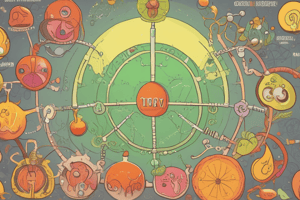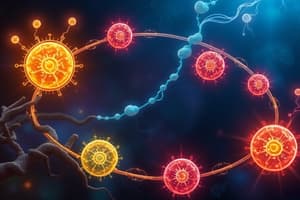Podcast
Questions and Answers
Which of the following is NOT a product of the citric acid cycle for each acetyl-CoA that enters?
Which of the following is NOT a product of the citric acid cycle for each acetyl-CoA that enters?
- CO2
- FADH2
- GTP (correct)
- NADH
The citric acid cycle occurs in the cytoplasm of eukaryotic cells.
The citric acid cycle occurs in the cytoplasm of eukaryotic cells.
False (B)
What is the starting molecule of the citric acid cycle?
What is the starting molecule of the citric acid cycle?
acetyl-CoA
The step in the citric acid cycle that converts succinyl-CoA to succinate is catalyzed by ______.
The step in the citric acid cycle that converts succinyl-CoA to succinate is catalyzed by ______.
Match the enzyme to the correct step of the citric acid cycle:
Match the enzyme to the correct step of the citric acid cycle:
How many NADH molecules are produced from one molecule of acetyl-CoA during the citric acid cycle?
How many NADH molecules are produced from one molecule of acetyl-CoA during the citric acid cycle?
The citric acid cycle is a key part of anaerobic respiration.
The citric acid cycle is a key part of anaerobic respiration.
Name one of the key benefits of the citric acid cycle in multicellular organisms.
Name one of the key benefits of the citric acid cycle in multicellular organisms.
The compound formed when acetyl-CoA combines with oxaloacetate is called ______.
The compound formed when acetyl-CoA combines with oxaloacetate is called ______.
Which step of the citric acid cycle involves the conversion of fumarate to malate?
Which step of the citric acid cycle involves the conversion of fumarate to malate?
Flashcards
What is the Citric Acid Cycle?
What is the Citric Acid Cycle?
The citric acid cycle is a central metabolic pathway that occurs in the mitochondrial matrix of eukaryotic cells. It's a series of eight enzymatic reactions that break down acetyl-CoA, generating energy in the form of ATP, NADH, and FADH2.
Why is the Citric Acid Cycle important?
Why is the Citric Acid Cycle important?
The citric acid cycle is a key component of aerobic respiration, the primary way that organisms generate energy from food. It's responsible for the majority of ATP produced in this process.
What starts the Citric Acid Cycle?
What starts the Citric Acid Cycle?
The citric acid cycle begins with acetyl-CoA, a molecule produced from the breakdown of glucose in glycolysis. This two-carbon unit enters the cycle and is gradually oxidized through a series of reactions.
How many steps are in the Citric Acid Cycle?
How many steps are in the Citric Acid Cycle?
Signup and view all the flashcards
What are the key products of the Citric Acid Cycle?
What are the key products of the Citric Acid Cycle?
Signup and view all the flashcards
Is the Citric Acid Cycle a closed loop?
Is the Citric Acid Cycle a closed loop?
Signup and view all the flashcards
Does the Citric Acid Cycle have other roles?
Does the Citric Acid Cycle have other roles?
Signup and view all the flashcards
How does the Citric Acid Cycle relate to evolution?
How does the Citric Acid Cycle relate to evolution?
Signup and view all the flashcards
Why is the Citric Acid Cycle so important?
Why is the Citric Acid Cycle so important?
Signup and view all the flashcards
Study Notes
Citric Acid Cycle Overview
- The citric acid cycle, also known as the Krebs cycle or the tricarboxylic acid cycle, is an eight-step pathway requiring eight separate enzymes.
- This cycle takes place in the mitochondrial matrix of eukaryotic cells.
- The cycle is responsible for generating energy in the form of ATP, NADH, and FADH2.
- The cycle is a key part of aerobic respiration, which is the primary way that organisms generate energy from food.
- The cycle begins with acetyl-CoA, produced from the breakdown of glucose in glycolysis.
Steps of the Citric Acid Cycle
- Step 1: Citrate Synthase: Acetyl-CoA combines with oxaloacetate to form citrate.
- Step 2: Aconitase: Citrate is converted to isocitrate.
- Step 3: Isocitrate Dehydrogenase: Isocitrate is oxidized and decarboxylated to form alpha-ketoglutarate.
- Step 4: Alpha-Ketoglutarate Dehydrogenase: Alpha-ketoglutarate is oxidized and decarboxylated to form succinyl-CoA.
- Step 5: Succinyl-CoA Synthetase: Succinyl-CoA is converted to succinate, generating one GTP molecule.
- Step 6: Succinate Dehydrogenase: Succinate is oxidized to fumarate, generating FADH2.
- Step 7: Fumarase: Fumarate is hydrated to form malate.
- Step 8: Malate Dehydrogenase: Malate is oxidized to oxaloacetate, regenerating the starting molecule for the cycle.
Energy Yield from the Citric Acid Cycle
- For every acetyl-CoA that enters the cycle, the following molecules are produced: three NADH, one FADH2, and one ATP.
- Since one glucose molecule produces two pyruvate molecules in glycolysis, and therefore two acetyl-CoA molecules, the total yield per glucose molecule is doubled.
Importance of the Citric Acid Cycle
- The citric acid cycle is an essential pathway for cellular respiration, providing the majority of the ATP produced in aerobic respiration.
- The cycle also provides intermediates for other important metabolic pathways, such as amino acid synthesis and gluconeogenesis.
- The citric acid cycle is a critical part of the evolution of multicellular organisms, as it allows for more efficient energy production compared to anaerobic respiration.
Studying That Suits You
Use AI to generate personalized quizzes and flashcards to suit your learning preferences.




